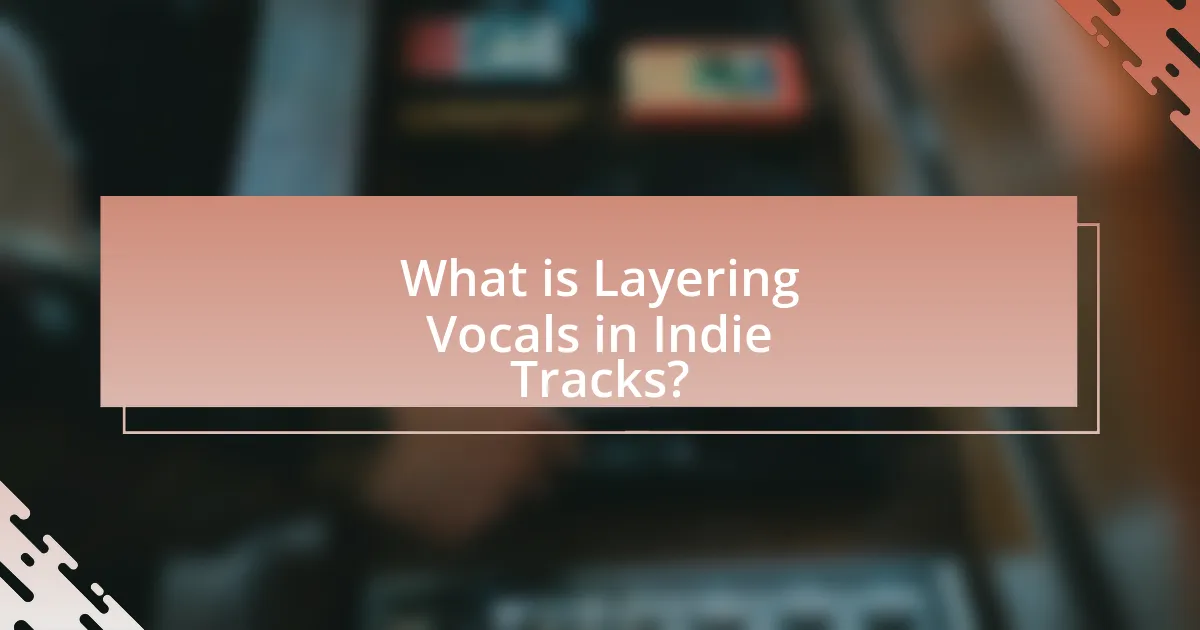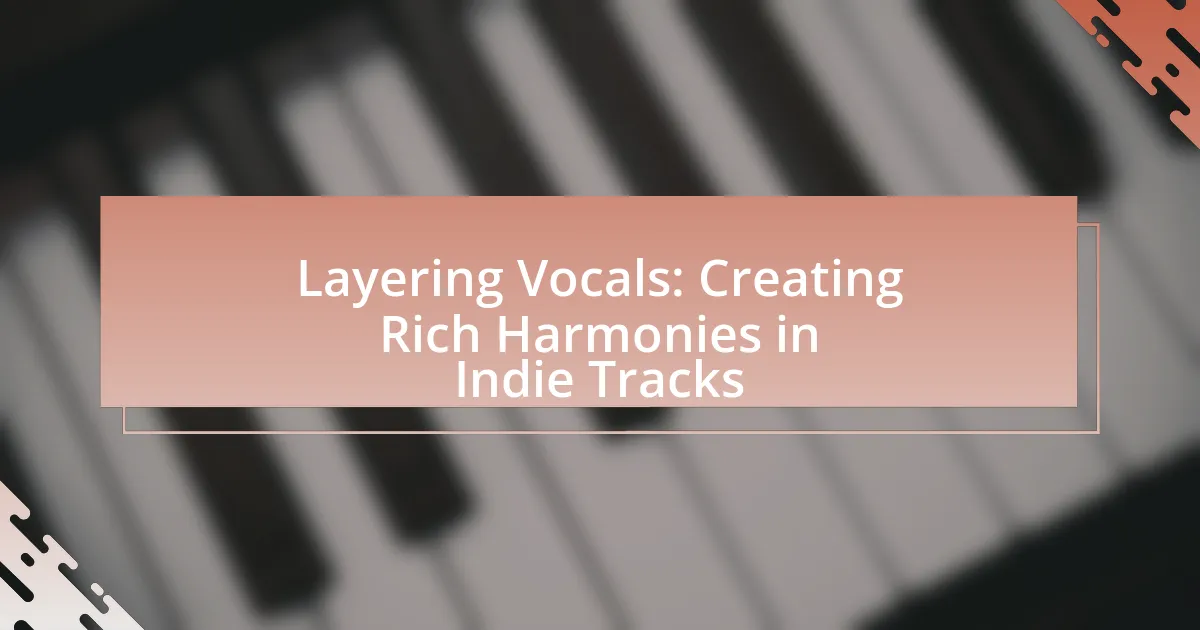Layering vocals is a crucial technique in indie music that involves recording multiple vocal parts to create a fuller and richer sound. This method enhances the emotional depth and texture of tracks, allowing for harmonies and counter-melodies that contribute to the overall atmosphere. Key elements of vocal layering include harmony, texture, and spatial placement, which work together to produce engaging vocal arrangements. The article explores how vocal layering enhances the emotional impact of songs, differentiates indie music from mainstream genres, and provides best practices and techniques for effective vocal layering, including the use of digital audio workstations and common mistakes to avoid.

What is Layering Vocals in Indie Tracks?
Layering vocals in indie tracks refers to the technique of recording multiple vocal parts and combining them to create a fuller, richer sound. This method enhances the emotional depth and texture of the music, allowing for harmonies and counter-melodies that contribute to the overall atmosphere of the track. Many indie artists utilize this technique to achieve a unique sonic identity, often experimenting with different vocal styles and effects to enrich their sound.
How does layering vocals enhance the overall sound of a track?
Layering vocals enhances the overall sound of a track by creating depth and richness that single vocal lines cannot achieve. This technique allows for the blending of multiple vocal harmonies, which adds texture and complexity to the music. For instance, when different vocal parts are combined, they can fill out the frequency spectrum, making the track sound fuller and more engaging. Studies in music production have shown that tracks with layered vocals often receive higher listener engagement due to their dynamic soundscapes.
What are the key elements of vocal layering in music production?
The key elements of vocal layering in music production include harmony, texture, and spatial placement. Harmony involves stacking multiple vocal tracks to create rich, complex chords that enhance the emotional impact of the music. Texture refers to the use of different vocal styles, such as lead, backing, and ad-libs, which contribute to a fuller sound. Spatial placement is achieved through panning and reverb, allowing each vocal layer to occupy its own space in the mix, creating a sense of depth and dimension. These elements work together to produce a cohesive and engaging vocal arrangement that enhances the overall quality of the track.
How does vocal layering contribute to the emotional impact of a song?
Vocal layering enhances the emotional impact of a song by creating depth and richness in the sound, which can evoke stronger feelings in listeners. This technique allows multiple vocal tracks to blend harmoniously, adding texture and complexity that can amplify the song’s mood. For instance, studies show that layered vocals can elicit emotional responses by engaging listeners’ auditory perception more fully, as seen in genres like indie music where harmonies often reflect the lyrical themes of vulnerability and connection. The use of vocal harmonies can also create a sense of unity or contrast, further intensifying the emotional experience.
Why is vocal harmony important in indie music?
Vocal harmony is important in indie music because it enhances emotional depth and creates a richer listening experience. The use of layered vocal harmonies allows artists to convey complex feelings and narratives, making the music more relatable and engaging. For instance, bands like Fleet Foxes and Bon Iver utilize intricate vocal harmonies to evoke a sense of community and introspection, which resonates deeply with listeners. This technique not only adds texture to the sound but also distinguishes indie music from other genres, emphasizing its artistic expression and individuality.
What role do harmonies play in creating a unique sound?
Harmonies play a crucial role in creating a unique sound by adding depth and richness to music. When multiple vocal parts are layered, they interact to produce a fuller auditory experience, distinguishing a track from others. For instance, in indie music, harmonies can evoke specific emotions and enhance lyrical themes, making the sound more memorable. Research indicates that songs with rich harmonies are often perceived as more engaging and emotionally resonant, which can lead to increased listener retention and preference.
How can harmonies differentiate an indie track from mainstream music?
Harmonies can differentiate an indie track from mainstream music by employing unconventional chord progressions and vocal arrangements. Indie music often features layered harmonies that create a unique sound texture, contrasting with the more formulaic and polished harmonies typically found in mainstream tracks. For instance, indie artists frequently experiment with dissonance and unexpected intervals, which can evoke a more emotional or introspective response. This approach is supported by the fact that many successful indie tracks, such as those by Bon Iver or Sufjan Stevens, utilize rich vocal harmonies that diverge from the standard pop structure, showcasing individuality and artistic expression.
What techniques are used for effective vocal layering?
Effective vocal layering techniques include using multiple takes, panning, and harmonization. Multiple takes involve recording the same vocal line several times to create a fuller sound, which is a common practice in professional music production. Panning refers to distributing vocal tracks across the stereo field, enhancing spatial depth and clarity. Harmonization involves adding different vocal pitches to create rich, complex textures, which is essential in genres like indie music. These techniques collectively contribute to a polished and immersive listening experience.
How can pitch and timing adjustments improve vocal layers?
Pitch and timing adjustments can significantly enhance vocal layers by creating a more cohesive and harmonious sound. When pitch is adjusted, it allows for the creation of harmonies that complement the main vocal line, enriching the overall texture of the track. For instance, slight pitch shifts can introduce subtle variations that make the vocals feel fuller and more dynamic. Timing adjustments, such as slight delays or variations in rhythm, can add depth and interest, making the vocal layers feel more alive and engaging. Research indicates that well-timed vocal layers can evoke emotional responses in listeners, enhancing the impact of the music. Therefore, both pitch and timing adjustments are essential techniques for achieving rich and compelling vocal harmonies in indie tracks.
What are the best practices for recording layered vocals?
The best practices for recording layered vocals include ensuring proper microphone placement, using a consistent vocal performance, and applying appropriate effects during mixing. Proper microphone placement, typically 6 to 12 inches from the vocalist, captures clarity and reduces unwanted noise. Consistency in vocal performance is crucial; singers should aim to replicate the same energy and pitch across layers to maintain harmony. Additionally, applying effects like reverb and delay during mixing enhances the depth and richness of the layered vocals, creating a fuller sound. These practices are supported by audio engineering principles that emphasize clarity, consistency, and spatial enhancement in vocal recordings.
How can one transition from basic layering to advanced techniques?
To transition from basic layering to advanced techniques in vocal layering, one should incorporate harmonies, counter-melodies, and dynamic variations. By adding harmonies, singers can create depth; for instance, using third and fifth intervals enhances richness. Counter-melodies introduce complexity, allowing different vocal lines to interact, which can be seen in successful indie tracks. Additionally, employing dynamic variations, such as volume changes and vocal effects, can create a more engaging soundscape. These techniques are supported by the practices of renowned producers who emphasize the importance of texture and interplay in vocal arrangements.
What tools and software are essential for vocal layering?
Essential tools and software for vocal layering include digital audio workstations (DAWs) like Ableton Live, Logic Pro, and Pro Tools, as well as plugins such as Melodyne for pitch correction and Waves’ Vocal Rider for level balancing. These DAWs provide the necessary environment for recording and arranging multiple vocal tracks, while plugins enhance the quality and coherence of layered vocals. For instance, Ableton Live is known for its intuitive interface and powerful audio manipulation capabilities, making it a popular choice among indie artists for creating rich harmonies.
What are the common mistakes to avoid when layering vocals?
Common mistakes to avoid when layering vocals include neglecting pitch alignment, failing to create distinct vocal textures, and overusing effects. Pitch alignment is crucial; if layers are not in tune, they can clash and create dissonance, detracting from the overall harmony. Distinct vocal textures help maintain clarity; using similar vocal tones can lead to a muddy mix. Overusing effects like reverb or delay can overwhelm the vocals, making them less intelligible. These mistakes can significantly impact the quality of the final mix, as evidenced by numerous production guides emphasizing the importance of clarity and balance in vocal layering.
How can improper layering affect the mix of a track?
Improper layering can lead to a cluttered and unbalanced mix in a track. When vocal layers are not harmonically or rhythmically aligned, they can create frequency masking, where certain sounds overpower others, resulting in a lack of clarity. This can diminish the overall impact of the vocals, making them sound muddy or indistinct. Additionally, improper layering can cause phase issues, where sound waves interfere with each other, further degrading audio quality. Studies in audio engineering emphasize that well-executed layering enhances depth and richness, while poor layering detracts from the listener’s experience.
What are the signs of over-layering in vocal tracks?
The signs of over-layering in vocal tracks include a lack of clarity, muddiness in the mix, and phase cancellation issues. When multiple vocal layers are excessively stacked, the distinctiveness of each layer diminishes, leading to a sound that feels congested and unclear. Muddiness occurs when frequencies overlap excessively, particularly in the mid-range, causing the overall sound to lose definition. Additionally, phase cancellation can happen when vocal tracks are not aligned properly, resulting in certain frequencies being diminished or canceled out entirely, which can further detract from the overall quality of the mix.
What tips can help achieve rich harmonies in indie tracks?
To achieve rich harmonies in indie tracks, layering multiple vocal tracks with varying pitches and textures is essential. This technique allows for a fuller sound, as each layer contributes unique tonal qualities. Additionally, using harmonies that complement the melody, such as thirds and fifths, enhances the overall richness. Employing effects like reverb and delay can further add depth and space to the harmonies, making them more immersive. Studies in music production emphasize that well-structured vocal arrangements can significantly elevate the emotional impact of a track, reinforcing the importance of thoughtful layering and harmony choices.


